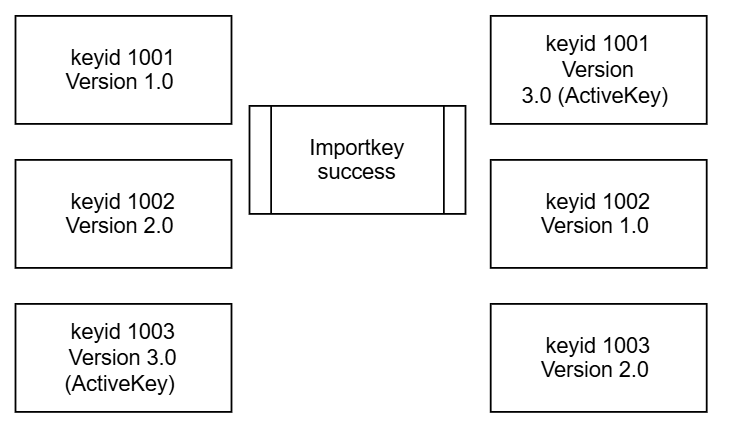Master Session Key Concept
Available soon
While Terminal-to-Host connections typically use DUKPT encryption, Host-to-Host connections may also make use of the so called Master-Session Key (MSK) encryption for PIN and PAN.
There are two parts that need to be followed in order to use MSKs:
- Offline exchange of zone master keys between Fiserv and you as an integrator (separate keys for PAN and PIN)
- Periodic rotation of session keys and encryption of transaction data using the session key during the flow
Pre-Requisites
- Two AES 256-bit Master Keys (Zone Master Key or Transport Key) (one for SRED, one for PIN) must be exchanged offline between you and Fiserv
- The labels for
masterKeyLabelandsessionKeyLabelhave been agreed
Session Key Management
Key Import
To start using encrypted transactions, you’ll need to import a session key using the Key Management API. This API is secured with TLS 1.2 or higher, and requires both Mutual Authentication and Basic Authorization.
- The session keys must be AES 128-bit, formatted in TR-31 key block format, and encrypted using a Zone Master Key (ZMK) that is identified by a label called masterKeyLabel.
- You’ll need to generate two types of session keys:
- For PIN encryption: Use KeyUsage ZPK (Zone PIN Key). This key should be AES 128-bit, in TR-31 format, and encrypted under the PIN master key (pin
masterKeyLabel). - For SRED encryption: Use KeyUsage DEK (Data Encryption Key). This key should also be AES 128-bit, in TR-31 format, and encrypted under the PAN master key (pan
masterKeyLabel).
- For PIN encryption: Use KeyUsage ZPK (Zone PIN Key). This key should be AES 128-bit, in TR-31 format, and encrypted under the PIN master key (pin
API Endpoint
Endpoint: POST .../key-management/keys/import
Request parameters:
| Field | Description | Presence |
|---|---|---|
requestType | Indicates kind of request to be performed Use value 'ImportKeyRequest' | M |
keyType | Indicates type of session key to be rotated Possible values 'PAN' or 'PIN' | M |
masterKeyLabel | Unique label identifying the Master Key | M |
sessionKeyLabel | Label identifying the Session Key | M |
sessionKey | AES 128-bit key in TR-31 format | M |
sessionKeyCheckValue | Check value for validation | M |
Example:
{
"requestType": "ImportKeyRequest",
"keyType": "PAN",
"masterKeyLabel": "ZMK_PAN_XXX_YYY",
"sessionKeyLabel": "DEK_XX_XXYY",
"sessionKey": "B0080P0TN00N000041664BFCB3C43B151D024BFECFB43BD789CB666C16BB04028873D6F5B6C1D42F",
"sessionKeyCheckValue": "CE1CDE"
}
{
"type": "importKeyResponse",
"clientRequestId": "6af17b4f-3e07-44f9-9b09-cf84ab3b485d",
"keyType": "PAN",
"masterKeyLabel": "ZMK_PAN_XXX_YYY",
"sessionKeyLabel": "DEK_XX_XXYY",
"sessionKeyId": "1201",
"sessionKeyCheckValue": "CE1CDE"
}
Exception scenarios:
| Scenario | HTTP code | error.code / error.message |
|---|---|---|
| Duplicate Import Key request. | 409 | 301 - Session key has already been imported |
| Unable to retrieve response while importing session key | 409 | 3067 -Unable to retrieve response while importing session key |
| Unauthorized | 401 | 401 - Unauthorized |
| Server error occurred while importing session key | 409 | 3901 - Server error occurred while importing session key |
| Internal Server Error | 500 | 1001 - Internal Server Error |
Additional note
In case of a timeout during the Import Key process, it is recommended to initiate a Get Keys request to retrieve the keys associated with the session key label and confirm whether the import was successful at IPG.
Additionally, to avoid potential conflicts, it is advised not to perform multiple successful Import Key requests within a short time frame.
Session Key Rotation
Once the session key is successfully imported, the sessionKeyId returned in the response becomes the active key. This key can then be used for PAN re-encryption or PIN translation.
The gateway maintains up to three session keys per sessionKeyLabel, each one identified by sessionkeyid in the response.
How it works
-
The gateway maintains 3 static Key IDs (e.g., 1001, 1002, 1003).
-
Each Key ID has a version (e.g., 1.0, 2.0, 3.0).
-
When a new key is imported:
- It is added to the Key ID with the lowest version.
- That Key ID is then rotated to have the highest version.
- The previous highest version is downgraded accordingly.
-
The Key ID with the highest version is always the active key used for encryption.

Retrieve Session Key Details
To retrieve details of a specific session key, use the following endpoint:
API Endpoint
Endpoint:
GET .../keys/{sessionKeyId}
Example:
{
"type": "getKeyResponse",
"clientRequestId": "testuuid",
"key": {
"keyType": "PAN",
"sessionKeyLabel": "DEK_XX_XXYY",
"sessionKeyId": "99",
"sessionKeyCheckValue": "5AB19C",
"version": "2.0"
}
}
Retrieve All Session Keys
To retrieve all session keys associated with a specific sessionKeyLabel, use the following endpoint:
sessionKeyid with the highest version is the active key to be used for transactions.
API Endpoint
Endpoint:
GET .../key-mgmt/session-keys/keys/sessionKeyLabel={sessionKeyLabel}
Example:
{
"type": "getKeysResponse",
"clientRequestId": "TestKeyMgmt",
"apiTraceId": "aGHOa5LKbwclIS3C4oh6pQAAATo",
"keys": [
{
"keyType": "PAN",
"sessionKeyLabel": "DEK_XX_XXYY",
"sessionKeyId": "25",
"sessionKeyCheckValue": "0DDC0A",
"version": "3.0"
},
{
"keyType": "PAN",
"sessionKeyLabel": "DEK_XX_XXYY",
"sessionKeyId": "26",
"sessionKeyCheckValue": "2990D4",
"version": "1.0"
},
{
"keyType": "PAN",
"sessionKeyLabel": "DEK_XX_XXYY",
"sessionKeyId": "27",
"sessionKeyCheckValue": "E3AFC6",
"version": "2.0"
}
]
}
Transaction Processing
The usage of master session keys in the various submission components is described here:
SOAP API: link
Updated about 3 hours ago